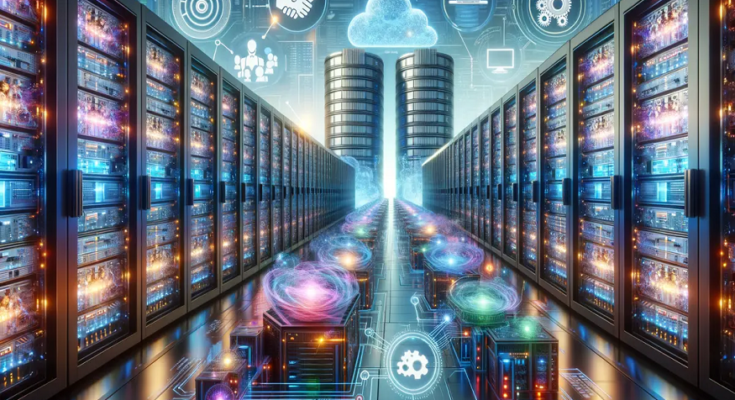In today’s digital age, data is at the heart of everything—from the apps we use daily to the operations of billion-dollar corporations. With the rapid growth of technologies like artificial intelligence (AI), the Internet of Things (IoT), and cloud computing, the demand for faster, smarter, and more efficient data processing has skyrocketed. This is where next-generation data centers come in. These aren’t your traditional server rooms—they are powerful, highly automated, scalable facilities designed to handle the growing complexity and volume of modern data. Next-gen data centers are essential for businesses looking to stay competitive, responsive, and secure in a data-driven world. They bring more than just storage—they bring intelligence, speed, energy efficiency, and adaptability. In this article, we’ll explore the importance of a next gen datacenter, how they differ from traditional ones, and the top reasons why organizations across the globe are making the shift today.
1.Greater Speed and Performance
Next-generation data centers are built with high-performance computing in mind. They use advanced processors, optimized storage systems, and high-speed networking that significantly improve data processing capabilities. This means faster responses for websites, quicker access to information, and better performance for data-heavy applications such as machine learning or big data analytics. In today’s fast-paced business environment, speed isn’t just a bonus—it’s a necessity. Whether it’s serving customers in real-time or powering complex AI systems, the speed of a next-gen data center can offer a huge competitive advantage.
2. Scalability to Grow With Business Needs
Modern businesses grow quickly, and their IT infrastructure needs to keep up. Traditional data centers often require physical changes and downtime to expand. In contrast, next-gen data centers are built with scalability at their core. They use modular designs and virtualized resources that allow companies to scale up or down based on demand—without affecting performance. This flexibility is especially important for startups, e-commerce platforms, and enterprises that experience seasonal traffic or rapid growth. With a next-gen data center, expansion is smoother, faster, and less expensive.
3. Advanced Automation and Management
One of the key features of next-gen data centers is automation. These facilities use AI and machine learning to monitor systems, detect issues, and even fix problems without human intervention. From managing workloads to adjusting energy use based on server activity, automation makes the entire process more efficient.Automation also helps businesses maintain high uptime and meet service level agreements (SLAs) more effectively.
4. Improved Energy Efficiency and Sustainability
As environmental concerns grow, energy efficiency in IT infrastructure is becoming a priority. Next-gen data centers are designed to be greener and more energy-efficient than their predecessors. They use smart cooling systems, energy-efficient hardware, and sometimes even renewable energy sources to reduce their environmental impact. Lower power consumption not only helps the planet but also saves businesses money on operational costs. With growing regulations and consumer demand for sustainable practices, using a next-gen data center can also enhance a company’s public image and ESG (Environmental, Social, and Governance) profile.
5. Enhanced Security Features
Data is a valuable asset, and protecting it is more critical than ever. Next-gen data centers are equipped with robust, multilayered security systems that go far beyond traditional locks and passwords. These include biometric access controls, real-time threat detection, encrypted data storage, and advanced cybersecurity protocols. With cyberattacks becoming more sophisticated, businesses need a data center that can stay one step ahead. By using next-gen facilities, organizations can better safeguard sensitive information, ensure regulatory compliance, and build trust with their clients and stakeholders.
6. Support for Emerging Technologies
Next-gen data centers are designed to support these new technologies by providing the low latency, high bandwidth, and real-time processing capabilities they require. Whether it’s processing data from self-driving cars or powering predictive analytics in healthcare, the next-gen infrastructure provides the backbone that modern innovation depends on. Investing in this technology is an investment in staying relevant in a fast-changing world.
7. Reliable Disaster Recovery and Business Continuity
Downtime can cost companies thousands—even millions—of dollars. Next-gen data centers offer more reliable disaster recovery systems to ensure your business stays online even during unexpected events. They often include multiple redundant systems, real-time data backups, and geographically diverse facilities to prevent total data loss. With features like live failover and automated recovery, businesses can continue operating with minimal interruption. This is especially important for industries like finance, healthcare, and e-commerce where any downtime could mean lost revenue or lives.
8. Virtualization and Containerization Support
Unlike traditional data centers, next-gen centers are optimized for virtualization and containerization, allowing businesses to run multiple applications and services efficiently on the same hardware. Technologies like VMware, Docker, and Kubernetes thrive in next-gen environments. This improves resource utilization and simplifies application deployment and management. For developers and IT teams, this means quicker releases, easier updates, and more efficient use of infrastructure—leading to faster innovation and lower costs.
9. Cost Optimization and Reduced Overhead
Next-gen data centers are more cost-effective in the long run. Their energy efficiency, automation, and virtualized environments reduce operational expenses. They also offer flexible pricing models, such as pay-as-you-go or cloud-based services, allowing businesses to control costs more effectively. For many companies, this means no longer needing to invest heavily in physical hardware or IT maintenance teams. The savings can be redirected into other areas of the business, such as product development, marketing, or customer service.
The importance of the next-generation future of datacenters cannot be overstated. They are not just an upgrade to old systems—they are a complete transformation of how we manage, protect, and use data in a digital-first world. With benefits ranging from speed and scalability to sustainability and security, next-gen data centers are the cornerstone of modern business infrastructure. They enable innovation, support emerging technologies, reduce costs, and prepare companies for whatever the future may bring. As the world becomes more connected and data-driven, investing in a next-gen data center is no longer a luxury—it’s a necessity. Businesses that embrace this shift today will be the ones leading the way tomorrow.




